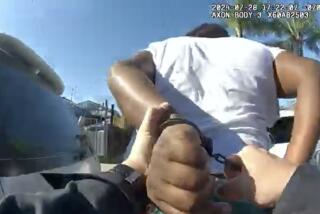Consumer oversight of the LAPD
- Share via
BLUE-RIBBON COMMISSIONS may get more publicity, but it is consumer technology that is setting the pace of police reform. In the Aug. 11 arrest of William Cardenas by two Los Angeles police officers, currently being investigated by the FBI and the Los Angeles Police Department, a bystander used her cellphone camera to capture one officer repeatedly slugging Cardenas in the face as he lay on the ground with both police officers on top of him. Now another arrest video has come to light, this one of an LAPD officer pepper-spraying a handcuffed suspect.
The Cardenas video was first posted on the website of Cop Watch Los Angeles, which collects complaints filed against officers. From there it migrated to YouTube.com, where it has been viewed almost 700,000 times. Finally it found its way to broadcast television.
It is a relatively recent development for police behavior to be subject to such close and instantaneous public scrutiny. The public was once dependent on TV photographers, with their then-bulky equipment, for images of controversial police activity. Then, in 1991, George Holliday was trying out his new video camera when he saw police officers clubbing Rodney King. His tape, replayed countless times on TV, changed history.
Today, any bystander is likely to be reasonably proficient with a cellphone camera and to have the know-how — or at least, a preteen at home with the know-how — to post the images on YouTube. That makes certain subjects, like arrests, more likely to be captured and displayed repeatedly. On YouTube are thousands of other arrest-related videos from around the world, in addition to the Cardenas clip.
That’s mostly a good thing. Public confidence in the police requires monitoring outside the regular channels of self-review, and technology has democratized the process. (Of course, it could also be used to subvert it.) The video-viewing blogosphere has become a sophisticated community, famous for ferreting out fakes and identifying nuances. The blog debate on the Cardenas beating is typical in that it includes the usual pro- and anti-police diatribes, but it goes further, spotlighting details of the video. Was the suspect, for example, pinching one of the officers in the thigh, and could that have justified the brutal punches?
The last word on the Cardenas arrest will remain with the LAPD, the FBI and the courts. But the last word on how Los Angeles is policed, which tactics are acceptable and which are beyond the pale, and whether the LAPD’s “warrior culture” has been sufficiently channeled belongs to the broader community. Consumer technology has made it possible for more members of that community to take part in the debate.
More to Read
Sign up for Essential California
The most important California stories and recommendations in your inbox every morning.
You may occasionally receive promotional content from the Los Angeles Times.









